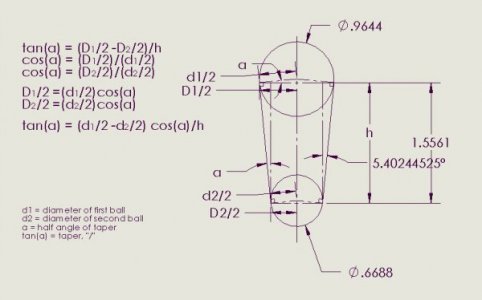- Joined
- Apr 7, 2014
- Messages
- 343
I was messing around with the idea of measuring a taper using two balls.
After I worked out the equation (which turned out to be pretty simple) and put it in a spreadsheet, I had to try it out.
I posted the attached video showing the measurement and spreadsheet.
The spreadsheet also has pages on measuring mouth openings of tapers. Joe Pi did a great video on measuring mouth openings with balls that got me thinking about measuring tapers using balls.
Here is Joe's video on measuring mouth openings using a gauge ball:
He is new to youtube, but has excellent machining tips.
I want to post the excel spreadsheet for free distribution.
Any ideas on the best way to do this? Update: link to EXCEL spreadsheet in post #5.
Thanks,
Chris
After I worked out the equation (which turned out to be pretty simple) and put it in a spreadsheet, I had to try it out.
I posted the attached video showing the measurement and spreadsheet.
The spreadsheet also has pages on measuring mouth openings of tapers. Joe Pi did a great video on measuring mouth openings with balls that got me thinking about measuring tapers using balls.
Here is Joe's video on measuring mouth openings using a gauge ball:
I want to post the excel spreadsheet for free distribution.
Any ideas on the best way to do this? Update: link to EXCEL spreadsheet in post #5.
Thanks,
Chris
Last edited:


